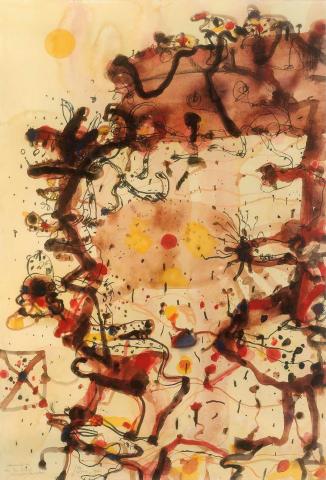ANIMALS IN THE YOU BEAUT COUNTRY REVISITED, 1994
John Olsen
watercolour and mixed media on paper
149.5 x 100.0 cm
signed and dated lower left: John / Olsen 94
inscribed lower left: Animals in / the You Beaut / Country Revisited
Private collection, Melbourne
One of the most striking features of John Olsen's watercolours is their aqueous quality. In his gifted hands, the fluidity of the medium is matched by his technique and often continued into the subject itself, especially those of frogs and lily ponds. There is also the overall lively movement, as in Animals in the You Beaut Country Revisited - it is another appealing characteristic of Olsen's work, expressing so effectively the pulse and passion of life. In this and many similar paintings, his style is a visual manifestation of the concept of the 'You Beaut Country', akin to Donald Horne's famous words 'The Lucky Country'. While irony was Horne's intention in choosing them as the title for his book of 1964, it grew to express all that is great about Australia. Significantly, Olsen's 'You Beaut' series of paintings had their debut in the early 1960s, Journey into the You Beaut Country numbers 1 and 2 belong to 1961, as does the brilliant Spring in the You Beaut Country, bursting with life and a new vision of the landscape. The paintings are in the collections of the National Gallery of Victoria, Queensland Art Gallery, and the National Gallery of Australia respectively. Like Horne's book, they had such an impact that the evocative words 'You Beaut Country' became part of our language and 'synonymous with Olsen's personality' and art.1 They are now counted among the icons of Australian art.
In Animals in the You Beaut Country Revisited, Olsen continues his visual explorations through the aerial view, the land seen from above and spread map-like before us. Seeking to convey a total experience, Olsen engages both seeing and feeling so that the viewer's greater involvement provides richer rewards in this journey of discovery. Fuelled by the overall mood of spontaneity, animal, plant and landforms are metamorphosed into the marvellously irrational imagery that is the idiosyncratic hallmark of Olsen at his best. While line may be his chief and cheekiest form of communication, colours pulsate and sparkle in harmony with the presentation of a landscape earthy, fecund, and disorderly - the visual counterpart to that larrikinism that is so much a part of the Australian character. Of the Australian landscape, Olsen said, 'It arranges itself like undisciplined graffiti - like a blue cattle dog's hind leg.'2
1. Hart, D., John Olsen, Craftsman House, Sydney, 1991, p. 58
2. ibid., p. 207
DAVID THOMAS
